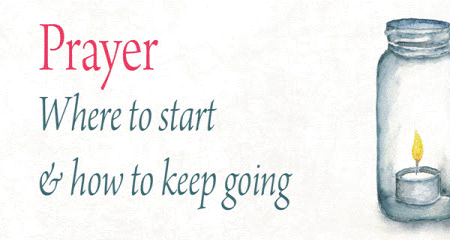


PART FIVE
What is prayer and
how do I start?
How do I pray with my family?
'The question I'm going to explore here isn't,
of course, relevant to everyone -
though it will be a very important one for some.
And many of the principles below can -
and, perhaps, should -
apply to how we pray as adults, too.'
In my experience, children love to pray.
Their ease with God spans Christian traditions.
They thrive on routine and will be in enthralled
by the comfort and the colour of ritual.
They love the Word of God
and will listen over and over again
to stories from the Bible.
Their prayer will be spontaneous,
joyful and creative.
When I first started to explore ways
of praying together at home
with small children, I looked around
for the books on the subject.
I couldn't find any.
There are plenty of books of
prayer for children, but nothing much
about how to pray with children.
Here are a few ideas for praying with
children and with teenagers and
as a whole family.
With children
With younger children
it is important to understand how they
develop and particularly the
importance of routine.
When our own children were small,
we tried to make prayer a natural part
of the day the rhythm of life.
Tea time, bath time, story time
and prayer time all followed each other
in a comfortingly familiar daily routine.
That prayer included daily rituals of
sitting down together,
lighting a candle and saying a set prayer.
But it also included spontaneity and creativity.
Using pictures the children had made themselves
as a focus of the prayer,
allowing them to give expression
to their prayer.
And making sure that the whole thing
was punctuated by stories
from the Bible.
Small children learn through play.
It is the way they come to
understand the world around them ...
we must make praying like playing.
Small children learn through play.
It is the way they come to understand
the world around them.
They reproduce the world through their play,
solving problems and re-enacting
its dramas and delights.
So, we must make praying like playing.
Whenever we pray in the home with children,
teenagers or as a couple,
or even on our own,
we need to try and weave together
these three elements.
Ritual -
using familiar prayers and secure patterns of
prayer and developing our own little family
rituals of prayer.
Spontaneity -
nurturing within ourselves
and in our households
ways of expressing prayer in response
to what has happened to us in the day.
Both thanksgiving and petition.
Play -
praying should be fun!
Some years ago,
a Sunday school teacher asked me if I had
noticed that adults' prayers usually
began with the word "please",
but children's prayers always
began with the words "thank you".
It is a most challenging observation.
When we adults come to God,
it tends to be with all the stuff we want
to ask God to do for us.
But children come with thanksgiving
on their lips.
So when we pray with children,
it is not us praying for them,
but us praying with them,
and asking them to lead us in prayer.
Often where we may dither and hesitate,
their praying gets right to the heart of
a situation in ways we find
embarrassing or difficult.
With teenagers -
Praying with teenagers
will always be more challenging.
Probably the most important lesson to learn
is not to force them or expect them
to join in if they don't want to.
Teenagers are very interested in God,
very interested in spirituality
and very committed to wanting to
change the world.
Given the right space and the
right conditions they will want
to give voice to their longing for God
and their longing for a better world.
In the home,
sometimes this will be best expressed by silence,
by images,
by listening to music,
by meditative reading.
And sometimes by discussion
which then may lead into prayer.
With teenagers this might be something
that happens once a week
rather than every day.
"You gave your Son to share
in the life of a family in Nazareth.
Help us to value our families,
to be thankful for them,
and to live sensitively with them."
New Patterns for Worship
Faith at home offers resources
to help us discover God
in the place we spend most of our time.
It includes support for families
in how to discuss faith and develop
their practices and habits together.
Find out more on our website.
Teenagers can teach the rest of us
a lot about prayer.
They will want to live their prayer,
and see prayer in action,
or they will soon lose interest.
They challenge the rest of us to see
the connection between prayer and life.
Prayer
Thank you for the world so sweet;
Thank you for the food we eat;
Thank you for the birds that sing;
Thank you God for everything
Amen.
(Edith Rutter-Leatham)
The material by Stephen Cottrell is taken from
the illustrated Church House Publishing book
and eBook Prayer:
Where to Start and How to Keep Going.
The text is © Stephen Cottrell 2020
and includes material adapted from How to Pray,
which is © Stephen Cottrell 1998, 2003, 2010
and is used here with permission of
the author and publishers.
Prayers from Common Worship volumes
and New Patterns for Worship are
copyright ©The Archbishops' Council
2000-2008 and 2002 respectively and are
published by Church House Publishing.
Used here with permission.
All rights reserved.
Scripture quotations are from the
New Revised Standard Version of the Bible,
Anglicized Edition, copyright © 1989, 1995
by the Division of Christian Education
of the National Council of
the Churches of Christ in the USA.
Used by permission. All rights reserved.
Illustrations are by www.penguinboy.net
Copyright ©2021. The Church of England. All rights reserved.